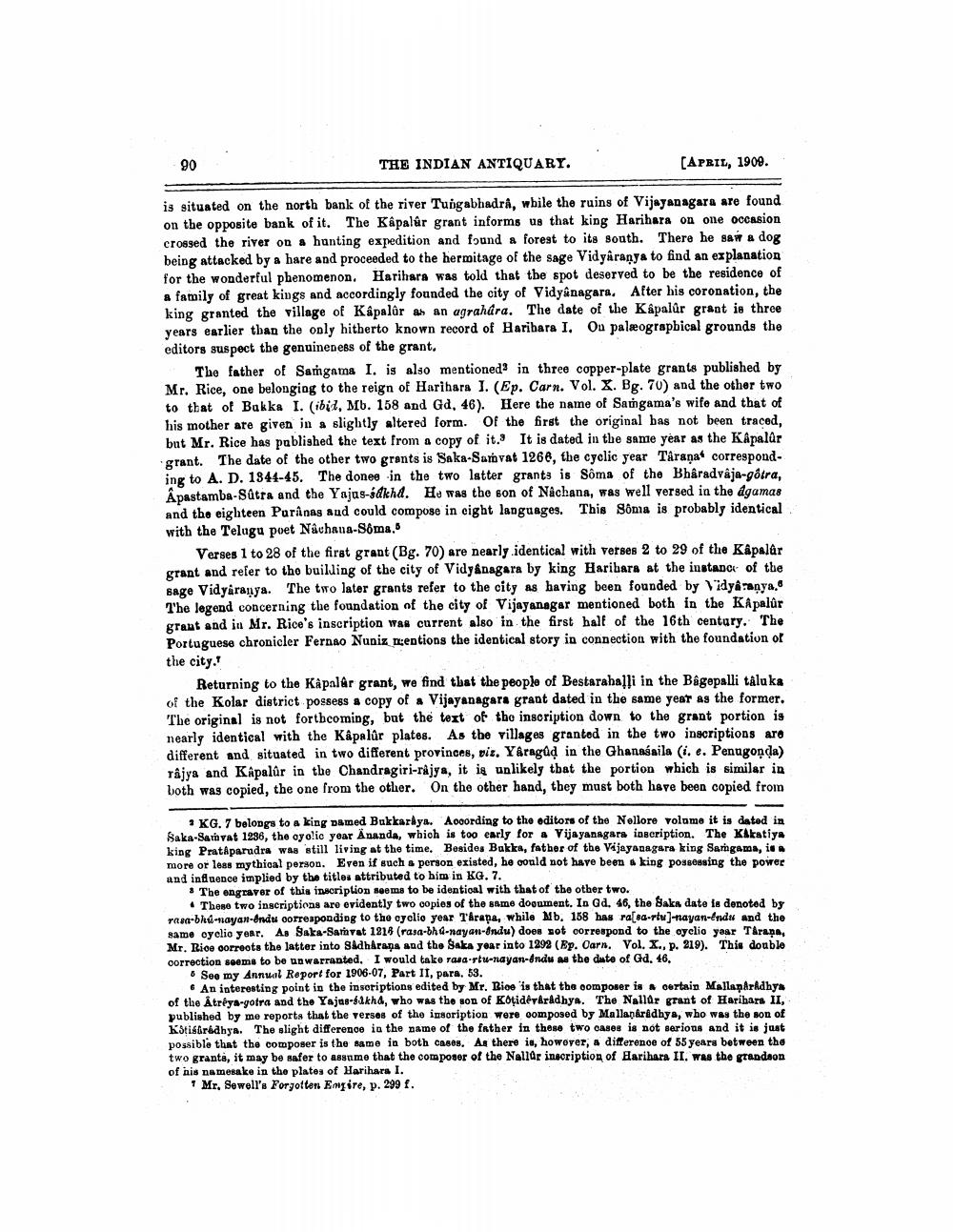________________
90
THE INDIAN ANTIQUARY.
[APRIL, 1909.
is situated on the north bank of the river Tungabhadrâ, while the ruins of Vijayanagara are found. on the opposite bank of it. The Kâpalûr grant informs us that king Harihara on one occasion crossed the river on a hunting expedition and found a forest to its south. There he saw a dog being attacked by a hare and proceeded to the hermitage of the sage Vidyaranya to find an explanation for the wonderful phenomenon. Harihara was told that the spot deserved to be the residence of a family of great kings and accordingly founded the city of Vidyanagara. After his coronation, the king granted the village of Kapalûr as an agrahara. The date of the Kapalûr grant is three years earlier than the only hitherto known record of Harihara I. Ou palæographical grounds the editors suspect the genuineness of the grant.
The father of Samgama I. is also mentioned in three copper-plate grants published by Mr. Rice, one belonging to the reign of Harihara I. (Ep. Carn. Vol. X. Bg. 70) and the other two to that of Bakka I. (ibid, Mb. 158 and Gd, 46). Here the name of Samgama's wife and that of his mother are given in a slightly altered form. Of the first the original has not been traced, but Mr. Rice has published the text from a copy of it. It is dated in the same year as the Kapalûr grant. The date of the other two grants is Saka-Samvat 1266, the cyclic year Taranas corresponding to A. D. 1844-45. The donee in the two latter grants is Sôma of the Bharadvaja-gotra, Apastamba-Sutra and the Yajus-sdkhd. He was the son of Nachana, was well versed in the agamas and the eighteen Parânas and could compose in eight languages. This Sôma is probably identical with the Telugu poet Nâchaua-Soma.5
Verses 1 to 28 of the first grant (Bg. 70) are nearly identical with verses 2 to 29 of the Kapalar grant and refer to the building of the city of Vidyanagara by king Harihara at the instance of the sage Vidyaranya. The two later grants refer to the city as having been founded by Vidyaranya. The legend concerning the foundation of the city of Vijayanagar mentioned both in the KApalûr grant and in Mr. Rice's inscription was current also in the first half of the 16th century. The Portuguese chronicler Fernao Nuniz mentions the identical story in connection with the foundation of the city.
Returning to the Kapalar grant, we find that the people of Bestarahalli in the Bâgepalli taluka of the Kolar district possess a copy of a Vijayanagara grant dated in the same year as the former. The original is not forthcoming, but the text of the inscription down to the grant portion is nearly identical with the Kâpalûr plates. As the villages granted in the two inscriptions are different and situated in two different provinces, viz. Yaragûd in the Ghanasaila (i. e. Penugonda) rajya and Kapalûr in the Chandragiri-rajya, it is unlikely that the portion which is similar in both was copied, the one from the other. On the other hand, they must both have been copied from
2 KG. 7 belongs to a king named Bukkaraya. According to the editors of the Nellore volume it is dated in Saka-Samvat 1236, the oyelic year Änanda, which is too early for a Vijayanagara inscription. The Kakatiya king Prataparadra was still living at the time. Besides Bakka, father of the Vijayanagara king Samgama, is a more or less mythical person. Even if such a person existed, he could not have been a king possessing the power and influence implied by the titles attributed to him in KG. 7.
The engraver of this inscription seems to be identical with that of the other two.
These two inscriptions are evidently two copies of the same document. In Gd. 46, the Saka date is denoted by rasa-bhu-nayan-endu oorresponding to the cyclio year Tarapa, while Mb. 158 has ra[sa-rtu]-nayan-fndu and the same oyclio year. As Saka-Samvat 1214 (rasa-bhú-nayan-indu) does not correspond to the cyclio year Tarana, Mr. Rice corrects the latter into Sadharana and the Saka year into 1292 (Ep. Carn. Vol. X., p. 219). This double correction seems to be unwarranted. I would take rasa-rtu-nayan-indu as the date of Gd. 46,
See my Annual Report for 1906-07, Part II, para. 53.
An interesting point in the insoriptions edited by Mr. Rice is that the composer is a certain MallanAradhya of the Atrêya-gotra and the Yajus-sakhd, who was the son of Kotidêvårådhya. The Nallur grant of Harihara II, published by me reports that the verses of the insoription were composed by Mallanârâdhya, who was the son of Kotisarádhya. The slight difference in the name of the father in these two cases is not serious and it is just possible that the composer is the same in both cases. As there is, however, a difference of 55 years between the two grants, it may be safer to assume that the composer of the Nallur inscription of Harihara II. was the grandson of his namesake in the plates of Harihara I.
1 Mr. Sewell's Forgotten Empire, p. 299 f.




